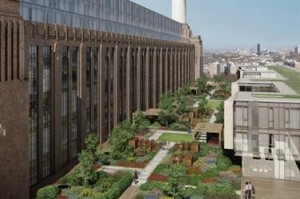by SARAH COSGROVE, Hosticulture Week, May 2, 2014

Battersea Power Station office and residential roof gardens
Image: Andy Sturgeon
Source: www.hortweek.com
Benefits of green roofs increasingly recognised by developers reinvigorating dead spaces, say leading garden designers.
Businesses are increasingly investing in roof gardens on top of corporate buildings to boost their business and benefit staff.
John Lewis opens a roof garden on its Oxford Street store on 3 May to celebrate its 150th anniversary, while garden designer Andy Sturgeon has revealed his designs for three Battersea Power Station office and residential roof gardens.
Construction is underway for the Gillespies-designed Sky Garden on top of London’s “Walkie Talkie” building (20 Fenchurch Street) and at a public roof garden on the new Canary Wharf Crossrail station.
RHS young designer of the year 2013 Tony Woods designed the John Lewis garden, with his company Garden Club London building it. The garden will be open to the public for 15 weeks for a series of events including a World Cup party.
Woods designed around a pop-up juice bar, restaurants and a kitchen and toilet block that had been airlifted onto the roof, where schoolchildren will grow vegetables and salads. Home-grown strawberries, rosemary and lavender will go to the caterers.
Woods said the garden references Britons’ love of gardening but “not in a museum way” and it features a greenhouse referencing John Lewis’s Longstock Estate as well as green walls. In the autumn the site will be changed into a “legacy garden” for John Lewis staff.
Woods said roof gardens are a growing market. “I think a lot of it is because a lot of office developers are refurbishing properties and reinvigorating dead spaces. They are really realising the value of having an outdoor space, particularly a space with a view where you can bring clients out for a cold drink in the summer and where staff can relax,” he said.
“A lot of people don’t really realise the benefits that come with green roofs. It’s getting the message across and really selling it as a desirable marketable product.”
Television ethnobotanist and garden designer James Wong is also designing a roof garden for a corporate headquarters. He pointed out that urban greening in his childhood home of Singapore is mandated by government but businesses soon realised that they could make money from them.
“I think Singapore has made green architecture trendy and us Brits are just riding the wave,” he said.
But garden designer Andrew Fisher Tomlin added: “Roof gardens on corporate sites have been around for a long time. They provide a wildlife environment but also a human environment in urban centres.
“We’ve done quite a few including those for developers and places like the Institute of Education. It’s not just a London thing but you may well find more in warmer climates than the UK just because roof gardens are particularly exposed to the weather, the most important factor being desiccation by wind and exposure to the elements. Water is the key factor and anything you can do to provide adequate systems for watering is vital.”
London Plan – Green infrastructure policy
The London Plan states that all major development proposals in central London must incorporate green infrastructure, including green roofs. The document also influences local plans.
A representative for the mayor of London said: “Green roofs are good for the environment and can improve our city’s resilience in the face of more frequent extreme weather by reducing the impact of storm water and mitigating the urban heat island effect.
“The mayor also works with partners to deliver green roofs on older buildings and has set a target for a five per cent overall increase in green cover by 2030.”